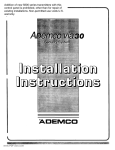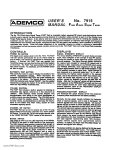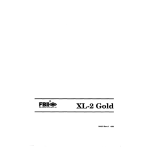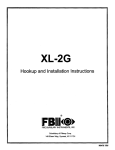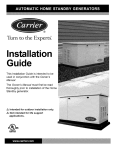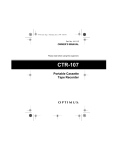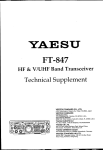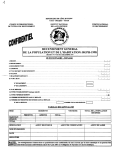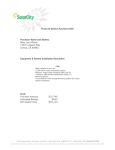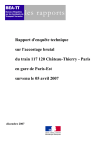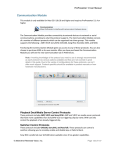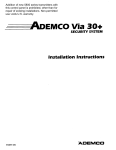Download 4120ec User Manual - Accel Communications
Transcript
4120EC SECURITY SYSTEM USER’S MANUAL N4861V4 9/92 TABLE OF CONTENTS lNTRoDucTloN ..... ........ . ....... ........ ........ ........ ........ ........ ............... ......3 FIRE AND BURGLARY PROTECTION ENTRY/EXITDELAYS .. .. .. .. ... .. .. .. ..... .. .. .... .. . .. .. ...... . .. .. .....4 . .. .. .. ... . .. ... .. .. .... .. .. ... .. .. .. .... ... .. ...... .. .. .. ..... .. .. .. .. ... . SECURllY CODES .... .. .. .... .. . .... ... . .. .. ... .. ..... . .. .. ... .. .. .. .... .. .. . ...... .. .. .. .. ...5 DURESS CODE ..... ... ..................... ......................................................5 FUNCTIONSOFTHECONSOLE DlsmMING mEsYswM cHIMEmE .. .... .. .. .. . .. .. .. .. .. .. . .. ...... .. . .. .... .. .. .. ... .. .. .. .. . 6 ANDslLENclNG AMRMs . .. .. .. ... .. ... .. .. .. ..... .. . ...8 .. .. .. .... .. .... ... .. .. .. .. .... .. . .... .... .. .... . .. .. .. .. .. .. .... ... .. ........ .. . ....8 CHECKING FOROPEN ZONES . ... . .. .... .. ..... .. .. ... .. .. .. .. .... . .. ...... .. .. . .... .. .... . 9 Bypassing PRoEcTloN zoNEs . .... .. .. ... .. .. .. ......<.. .... .. . ...... .. .. .. ..... .. ...9 ARMINGPERIMEIERONLY(STAY/lNSTANT) ARMINGALLPROTECTION . .. .. .. ... .... .. ... .. .. .. ... .. .. .. .......10 (AWAYMIMXIMUM) . .. .. .. ... .. .. ... .. .. .. ... .... .. .......11 PANlc KEYs . ...... .... ... . .. ... .. .... .. .. .. ... .. .. .... .... .. ... .. .. .... .. .. ..... .. .. .. .. .. ... ...l2 TESTINGTHESYSTEM . .. .... .. .. ... .. .. .... .. .. ... .. .. .. ...... . .. .... .. .. .. .. ... .. .. .. ......13 mouBLEmNDmloNs FIRE ALARM .. .... .. .. .... ... .. .... .. .. ..... .. .. .... .. . ...... .. .. .. ... .. .. .. ......l4 SYSTEM ............................... ..........................................l5 NATIONAL FIRE PROTECTION Emergency Evacuation SUMMARY OF AUDIBLE PRoEcTDN zoNEs ASSN. RECOMMENDATIONS .. .. .. .. .... . .. .. .. .. .. .. . .. .. .. .... .. . .... .. .. .. ... .. .. .. .. ....l7 NOTIFICATIONS Functions EMERGENCYPHONENUMBERS GLOSS~Y ...............................................l8 LlsT .. .. .. .. .. .. ... .. ...... .. .. ... .. .. .. .... . .. .... .. .. .. ... .. .. .. .. ..l9 QUICK GUIDE TO SYSTEM OWNER’SINSURANCE .....................16 .................................................l9 .. .. .... .. ... .... .. .. ..... .. .. .... .. . ...... .. .. ..... .. .. ..2O PREMIUMCREDIT REQUESTFORM .. .. . .. ... .. .. ... .. ...21 .. .. .... .. .. ... . . .... .. .. .. .. .. .. ... .. .. .... .. .. . .... .. .. .. .... ... .. .. .. .. .. .... .. . ...23 FCCSTATEMENT . .. .. .... .. .... . .. .... .. .. .. ... .. .. .... .. .. .. ... .. .. .... .. .. ... .. .. .. .. .... . ...25w ~ELIMITATONS -2- OF WISAMRM SYSEM .. .... .. . .... .. .. ... .. .. .. ... .. .. .. .......26 INTRODUCTION Congratulations on your ownership of a VISTA Security System. You’ve made a wise decision in choosing it, for it represents the latest in security protection ~chnology today. Basically, this system offers you three forms of protection: burglary, fire and emergency. To realize the system’s full potential, it is important that you feel comfortable in operating it. Your system consists of at least one Console which provides full control of system operation, various sensors which provide perimeter and interior burglary protection, plus a selected number of strategically placed smoke or combustion detectors designed to provide early warning in case of fire. The system uses microcomputer technology to monitor all protection zones and system status and provides appropriate information for display on the Console(s) used with the system, and initiates appropriate alarms. When programmed to do so, the system can also transmit appropriate alarm or status messages over the phone lines to a central alarm monitoring station. P. ItiEr=T r @aEiibiEq EI1313 m,, W,..s 9,?.ss Eimm .,.. Immm m Cc.x Eimm L.. J v 4127 4137 THE DISPLAY CONSOLES feature a multifunction, 12-key digital keypad, and uses a fixed-word English language/zone numeric LCD display which displays the nature and location of all occurrences. The consoles also have a built-in sounder. There are two fixed word consoles available. The 4137 features backlit keys, while the 4127 features a compact design (its keys are not backlit). –3- FIRE & BURGLARY PROTECTiON One or more sensing devices will have been assigned by the installer of your alarm system to each of the various protection zones in your system (although not every zone may have been used). For example, the sensing device on your Entry/Exit door may have been assigned to zone 01, sensing devices on windows in the master bedroom to zone 02, and so on. These numbers will appear on the display when the respective zone is faulted. The fire protection portion of your security system (if used) is always on and will sound an alarm if a fire condition is detected. Refer to the FIRE ALARM SYSTEM section for important information concerning fire protection, smoke detectors and planning emergency exit routes from your house. ENTRY/EXIT DELAYS Your system was programmed by the installer with a preset entry delay time, during which the system must be disarmed upon entering or an alarm will occur. This feature allows you to reenter through the entry delay door without setting off the alarm. A slow beeping will sound at the console to remind you to disarm the system. The entry delay feature can also be turned off for greater security when sleeping or while away for extended periods of time (INSTANT & MAXIMUM modes). A preset exit delay was also programmed to allow you time to leave the premises without setting off the alarm after arming the system. See your installer for your delay times. -4– The burglary protection portion of your system must be armed before it will sense burglary alarm condition When an alarm occurs, both th~ console and external sounders will sound, and a message in the Display Window will identify the zone(s) causing the alarm. In addition, if your system is connected to a central monitoring station, an alarm report will be sent. Disarming the system will stop alarm sounding. Your system provides four modes of burglary protection: STAY, AWAY INSTANT and MAXIMUM, and even allows you to BYPASS selected zones of protection while leaving the rest of the system armed. The system also provides a CHIME mode, for alerting users to the opening and closing of doors and windows while the system is disarmed. Refer to the other of this sections manual for procedures for using these features. Exit Entry Delay: Delay: o seconds o seconds Delays may be from 15 to 225 seconds in non-UL installations, but no more than 60 seconds for Ex delay or 45 seconds for Entry delayfor a UL Listed Household burglary application. SECURITY CODES At the time of installation, your installer programs a personal fourdigit code, known only to you and yours. This code must be entered when performing most system functions, including arming and disarming of the system. As an additional safety feature, up to 6 temporary codes can be assigned for use by those not having a need to know the master code. Temporary codes are assigned single-digit “User numbers” from 3 to 8. Before assigning a temporary code though, be sure it does not conflict with the DURESS code (see DURESS CODE section). Note that the master code remains in effect even when a temporary code is assigned. QUICK ARMING: Note that if “Quick Arming” was programmed by the installer, the [#] key can be pressed in place of the security code when arming the system. The security code is always required when disarming the Assign or deiete To TemDorarv Codes: E;ter Ma;ter code. i Press CODE [8] key. 3. Enter User Number to be assigned or deleted (3-8). 4. To assign a code, enter temporary code for that User Number. To delete a code, enter Master Code for that User Number. 5. The Console will beep once when procedure has been completed successfully. NOTE: Users to whom temporary codes have been assigned should not be shown how to bypass protection points unless they have a need to know. It is also recommended that obvious codes such as 1111 or 1234 not be assigned. / / } / / coosik DURESS (WHEN I il I 1 I QLicx AJIM XEY (lF PROGR#MME~ CODE FORCED TO DLSARM/ARM Enter the first three digits of the security code. Increase the final digit by one and then press OFF (or AWAY, etc. if arming the system). The system will disarm (or arm), but can silently notify the central station of your situation, if that service has been provided. For example, if the Normal security code is”1 23 4“, the Duress security code is”1 23 5“. UNDER THREAT) IMPORTANT ● ● ● This code is useful only when connected to a central station. Duress code capability is not present for codes ending in 9. Users of tempxaty codes must be instructed to enter their codes carefully to avoid the possibility of accidentally entering the Duress code. -5- u FUNCTIONS OF THE CONSOLE 1. DISPLAY WINDOW: Refer to the FIXED WORD DISPLAY CONSOLE System Status Display table on the next page for a list of messages that might appear along with their meanings. 2. OFF KEY: Disarms the burglary portion of the system, silences alarms and audible trouble indicators, and clears visual alarm trouble after the problem has been corrected. 3. AWAY KEY: Completely arms both perimeter and interior burglary protection for backup protection by sensing an intruder’s movements through protected interior areas as well as guarding doors, windows, etc. Late arrivals can enter through an entry delay zone without causing an alarm if the system is disarmed before the entry delay time expires. 4. STAY KEY: Arms the perimeter burglary protection, guarding doors, windows and other perimeter protection points, and sounds an alarm if one is opened. Interior protection is not armed, which allows movement within your house without causing an alarm. Late arrivals can enter through an entry delay zone without causing an alarm if the system is disarmed before the entry delay time expires. 5. TEST KEY: Tests the a!arm sounder if disarmed. Refer to the TESTING THE SYSTEM section for test procedures. 6. BYPASS KEY: Re m eves individual protection zones from being monitored by the system. Displays previously bypassed protection zones. 7. CHIME KEY: Turns on & off the CHIME mode. When on, any entry through a delay or perimeter zone while the system is disarmed will cause a tone to sound at the Console. -6- 8. [#] KEY: Permits ARMING of the system without use of a security code (“Quick Arm”, if programmed to do sc Used to enter y~ 9. KEYS O-9: individual security access code(s). 10. CODE KEY: Allows the entry of additional user codes that can be given to other users of the system. When 11. [*] READY KEY: depressed prior to arming the system, the console will display all open protection zones. Arms in 12. INSTANT KEY: manner similar to STAY mode, but turns off the entry delay period, offering greater security while inside and not expecting any late arrivals, An alarm will occur immediately upon opening any perimeter protection point, including entry delay zones. 13. MAXIMUM KEY: Arms in manner similar to AWAY mode, but eliminates the entry delay period, thus providing maximum protection. An alarm will occur immediately upon opening any protection point, including entry delay zones. 14. POWER INDICATOR: (GREEN) Lit when primary power is on. If off, system is operating on its backuD batterv oower. CALL YOUR INSTALLER IMMEDIATELY. (RED~ 15. ARMED INDICATOR: Lit when the system has been armed (STAY, AWAY, INSTANT or MAXIMUM). 16. INTERNAL SOUNDER: Source of audible internal warning and confirmation sounds, as well as alarms (see “Summary of Audible Notifications”). \ I \ \ IIIm -. \ .... / / / .... / p“”‘--”-‘ ‘= ‘ FIXED AWAY STAY INSTANT BYPASS NOT READY READY NO AC ‘ AC CHIME El-ARM CHECK FIRE WORD DISPLAY CONSOLE System Status Displays All burglary zones, interior & perimeter, are armed. Perimeter burglaty zones, such as windows & doors, are armed. Perimeter burglary zones armed and entry delay is turned off. One or more burglary protection zones have been bypassed. Appears when burglary portion of the system is not ready for arming (due to open protection zones). The burglary POrtion of the system is ready to be armed. Appears when AC power has been cut off. Appears when AC power is present. Aooears when the CHIME_ feature is activated. Appears when an intrusion has been detected and the system is armed (also appears during a Fire alarm). Accompanied by the protection zone ID in alarm. Appears when a malfunction is discovered in the system at any time or if a fault is detected in a FIRE zone at any time or in a DAY~lGHT burglaty zone during a disarmed period. Accompanied by a display of zone number in trouble. Appears when a fire alarm is present. Accompanied by a display of the zone in alarm. IMPORTANT!: When using the keypad to enter codes and commands, sequential key depressions must be made within 3 seconds of one another If 3 seconds elapses without a key depression, the entry ~is abortad and must be re eated from its b innin . -7- DISARMING THE SYSTEM AND SILENCING ALARMS (FOFi AWAY, STAY, INSTANT, AND PROCEDURE 1. Enter security code and press OFF [1]. The READY message will be displayed and the console will beep once to confirm that the system is disarmed, unless an alarm has occurred. 2. If an alarm has occurred, note the zone number displayed and repeat step 1 to restore the READY message display. If the message will not display, go tot he displayed protection zone and remedy the fault (close windows, etc.). If the fault cannot be remedied, notify the alarm agency. ~~ MAXIMUM ARMING) RESULT Any alarm sounders will be silence ALARM and zone number (~ displayed) will clear only when the open sensor is closed. A fire alarm is indicated by both FIRE and the zone the Console. These will when the fire zone is again a display of number on clear only intact. - See “SUMMARY OF AUDIBLE for section NOTIFICATION” information which will enable you to distinguish between FIRE and BURGIARY alarm sounds. ENTER PRESS OFF CHIME MODE ONLY WHEN THE SYSTEM IS DISARMED) To turn Chime Mode on, enter the security code and press the CHIME [9] key. The CHIM L message will appear. (THIS FEATURE IS FUNCTIONAL Your system can be set to alert you to the opening of a door or window while it is disarmed by using CHIME mode. When activated, three tones will sound at the Console whenever a door or window is opened, and the Not Ready message will be displayed. Pressing the READY [*] key will display the open zone number. Note that Chime mode can be activated only when the system is Disarmed. To turn Chime Mode off, enter the security code and press the CHIME [9] key again. The CHIME message will disappear. h , L la&lei fiiaixl rala~ cd m 0-” a ● ’-- qm> -- ‘ -81 ENTER CODE & PRESS CHIME CHECKING BEFORE WINDOWS FOR OPEN ZONES ARMING YOUR SYSTEM, AND OTHER PROTECTION ALL PROTECTED DOORS, ZONES MUST BE CLOSED. PROCEDURE lftheNOT READY messageis displayed priorto arming, check for open zones by depressing and releasing the READY [*] key (do not enter code first). All open protection points will be displayed. These” pints must be either closed or bypassed before the system can be armed. The READY message will be displayed when all protection zones have been either closed or bypassed. BYPASSING PROTECTION ZONES (FOR ARMING WITH ONE OR MORE ZONES SELECTIVELY PROCEDURE 1. System must be disarmed Enter security code. first. 2. Press BYPASS [6] and enter zone number(s) of zones to be bypassed (e.g., 01, 02, 03, etc.). Important! All single-digit zone numbers must be preceded by a zero (example, enter 01 for zone 1). 3. When finished entering all zone numbers to be bypassed, wait for bypassed zones to be sequentially displayed before arming. message will be 4. The BYPASS displayed indicating the presence of one or more bypassed zones. the system as usual. 5. Arm Bypassed zones are unprotected and will not cause an alarm when violated while system is armed. UNPROTECTED) NOTES: 1. All bypasses are removed when an OFF sequence (security code plus OFF) is performed. 2. Temporary users should not be shown how to bypass protection points unless they have a need to know. DISPLAYING BYPASSED ZONES (For determining what zones have been previously bypassed) 1. Enter security BYPASS [6]. code and press 2. Wait for all bypassed zones to be sequentially displayed. LIMITATIONS Fire or emergency zones cannot be bypassed. ● Arming the system before bypassed zones are displayed nullifies all bypasses. ● /A \ Eli cata U ● - ● -. –-@ qi_rmg -9- ARMING PERIMETER ONLY STAY: STAYING HOME, EXPECTING LATE ARRIVALS INSTANT: STAYING HOME, NO LATE ARRIVALS EXPECTED PROCEDURE 1. Enter the security code when the READY message is displayed. 2. Press the STAY [3] or INSTANT [71 key, depending on arming mode desired. STAY KEY RESULT Arms sensors guarding doors and windows, with entry delay on. Late arrivals can enter through the entry delay zone door and disarm the system within the entry delay period without causing an alarm. See your installer for actual delay times set for your system. Alarms will occur instantly when any exterior protection point is violated, except the entry delay zone door, which will activate an alarm if the system is not disarmed within the entry delay period. Interior protection points are disarmed to permit freedom of movement throughout the interior. –lo- 3. The armed state message will ~ displayed, accompanied by three beeps from the Console. Exit delay begins. Perimeter protection is in effect immediately, except entry delay zone if STAY key is pressed. INSTANT KEY RESULT Arms sensors guarding doors awindows, with entry delay off. Alarms will occur instantly when any exterior protection point is violated, including the entry delay zone door. Interior protection points are disarmed to permit freedom of movement throughout the interior. ARMING ALL PROTECTION AWAY: NO ONE STAYING HOME MAXIMUM: NO ONE STAYING HOME, =ROCEDURE ,. Enter the security code when the READY message is displayed. 2. Press the A W A Y [2] MAXIMUM [4] key, depending arming mode desired. or on MAXIMUM 3. The armed state message will be displayed, accompanied by two beeps from the Console. Exit delay begins [if programmed, a slow beeping will sound throughout the exit delay period]. Complete system protection is in effect immediately, except entry delay zone if AWAY key is pressed. / \ \ SECURITY ● ✎ ✎ -mm - . mlam D AnMCO ● POWm &WAY KEY RESULT Arms all perimeter and interior sensors, with entry delay on. You may exit during the exit delay period and reenter through the entry delay zone door (and disarm the system within the entry delay period) without causing an alarm. See your installer for actual delay times set for your system. Alarms will occur instantly when any protection point, interior or exterior, is violated, except the entry delay zone door if AWAY key pressed, which will activate an alarm if the system is not disarmed within the entry delay period. qmq MAXIMUM KEY RESULT Arms all perimeter and interior sensors, with entry delay off. You may exit during the exit delay period, BUT alarms will trigger instantly upon reentering, or when any protection point, interior or exterior, is violated. This mode is suggested when the premises will be vacant for extended periods of time such as vacations, etc., or when retiring for the night and no one will be moving through protected interior areas. -11- PANIC (FOR KEYS MANUALLY ACTIVATING SILENT There are two possible combinations of paired keys that are installer programmable emergency functions. See your installer for the functions that have been programmed for these emergency key pairs. Typical functions that might be programmed are Silent Police, Audible Police, Personal Emergency, and Fire. To use a Panic function, simpiy press both keys of the assigned pair at the same time and hold down for at /east two seconds. Active Panic Functions: KEY[*]+[q: (displayed KPf[q + es zone W) [3]: (displayedaszone%) A -12– AND/oR AUDIBLE ALARMS) RESULT If programmed for silent emergency b your installer, and the system ~ connected to a central alarm monitoring station, the control will send a silent alarm signal to the central station, but there will be no audible alarms or visual displays. If programmed for audible emergency by your installer, a loud, steady alarm will sound at your console and at any external sounders that may be connected. A personal emergency alarm will notify the central station (if connected) and will sound at consoles, but not at external belis or sirens. A fire alarm will send a fire alarm message to the centrai station and will uniquely sound external bells and sirens. TESTING (TO BE THE SYSTE M CONDUCTED WEEKL .Y) 1. Disarm the system. Enter security code and press the TEST [5] key. 3. The external sounder should sound for3 seconds and then turn If the sounder does not off . sound, it may be due to dialer communication activity. Wait a few minutes and try again. If the sounder still does not sound, CALL FOR SERVICE IMMEDIATELY. 4. Turn the Test mode off by entering the security code and preesing OFF. ARMED SYSTEM TEST Important! A message will be sent to the central alarm monitoring station (if the system is so connected) during the following tests. Notify them that a test will be in progress. Note: A display of FC on your console indicates a failure of the system to communicate with the alarm monitoring station . 1. Arm the system and fault each zone (open and close each protected doors or window). Silence the alarm sounder(s) each time by entering your ~ecurity code and pressing OFF. Check that Entry/Exit delay zones provide the assigned delay times (see page 4). panic 2. Check the keypad-initiated alarms, as indicated on page 12, by pressing keys [*]& [#], and [#] & [3]. If the system has been for programmed audible emergency, the console will emit a loud, steady alarm sound. When [*] and [#] are pressed, flLtl RM* and “99” will be displayed. When [#] and [3] are pressed, RLfl RM* and “96’ will be displayed. ●tlLRRM and/or FIRE may be displayed on the consoles. If a certain set of keys has been programmed for silent panic, there will be no alarms or displays; however, a silent message will be sent to the alarm monitoring station if the system has been so connected. 3. Disarm the system (security code plus OFF). 4. Notify the alarm monitoring station (if connected to one) that all tests are finished and verify results with them. 13 - TROUBLE CONDITIONS The word CHECK on the Console’s display, accompanied by a rapid “beeping” at the console, indicates that there is a trouble condition in the system. The audible warning sound for CHECK conditions may be silenced by pressing-any key. TYPICAL “CHECK” DISPLAYS 1. A disolay of CHECK accompanied bv a display hf one or more zone num6ers indicates that a problem exists with those zone(s), First, determine if the zone(s) displayed are intact and make them so if they are not. If the problem has been corrected, the display of the zone number(s) and CH EC K should disappear. If not, key an OFF sequence (Code plus OFF) to clear the display. If the display persists, CALL FOR SERVICE IMMEDIATELY. 2. A display of FC at the Console indicates that a failure has occurred in the telephone communication portion of your system. CALL FOR SERVICE IMMEDIATELY. 3. A display of OC indicates an open connection from the console to the control. CALL FOR SERVICE IMMEDIATELY. SERVICING 4. A disolav of CC indicates the control is in cor’nm’unicationwith a remote station. Effectively, the control is disabled during this time. Note that all alarms and troubles will be restored and annunciated when the system is returned to normal. 5. POWER FAILURE: If the POWER indicator is off, operating power for the system has stopped and is inoperative. CALL FOR SERVICE IMMEDIATELY. If the POWER indicator is on, but the message NO AC is displayed, the Console is operating on battery power only. If only some Ights are out on the premises, check circuit breakers and fuses and reset or replace as necessary. CALL FOR SERVICE IMMEDIATELY if AC power cannot be restored. INFORMATION: Your local authorized service representative is the person best qualified to service your alarm system. Arranging some kind of regular program with him is advisable. Your local service representative is: -14- FIRE ALARM SYSTEM (IF INSTALLED) Your fire alarm system (if installed) is on 24 hours a day, for continuous protection. In the event of an emergency, the strategically located smoke and heat detectors will automatically send sgnals to your Control/Communicator, “ - ~ering a loud, interrupted sound from the Console. An interrupted sound will be produced by optional exterior sounders. A FIRE message will appear at your tinsole and remain on until you silence the alarm. IN CASE OF FIRE ALARM: 1. Should you become aware of a fire emergency before your detectors sense the problem, go to your nearest Console and manually initiate an alarm by pressing the panic key pair assigned as FIRE emergency (if programmed by the installer) and hold down for at least 2 seconds. 2. Evacuate all occupants from the premises. and/or smoke are 3. If flames present, leave the premises and notify your local Fire Department immediately. or smoke are 4. If no flames apparent, investigate the cause of the alarm. The zone descriptor of the zone(s) in an alarm condition will be displayed at the Console. Note: “Approval of the panel’s burglar alarm functions does not fall within the (California) State Fire Marshal’s area of jurisdiction.” h SILENCING A FIRE ALARM: 1. Silence the alarm by entering your code and pressing the OFF key. To clear the display, enter your code and press the O F F key again. 2. If the Console does not indicate a READY condition after the second OFF sequence, press the READY [*] key to display the zone(s) that are faulted. Be sure to check that smoke detectors are not responding to smoke or heat producing objects in their vicinity. Should this be the case, eliminate the source of heat or smoke. not remedy the 3. If this does problem, there may still be smoke in the detector. Clear it by fanning the detector for about 30 seconds. has been 4. When the problem corrected, clear the display by entering your code and pressing the OFF key. I .,..,”,,-, m_l_m I Illln=n..”,0 ● -15- NATIONAL FIRE PROTECTION ASSN. RECOMMENDATIONS ON SMOKE DETECTORS With regard to the number and placement of smoke/heat detectors, we subscri~ to the recommendations contained in the National Fire Protection Association’s Standard #74 noted below. Early warning fire detection is best achieved by the installation of fire detection equipment in all rooms and areas of the household as follows: A smoke detector installed outside of each separate sleeping area, in the immediate vicinity of the bedrooms and on each additional story of the family living unit, including basements and excluding crawl spaces and unfinished attics. In addition, it is recommended that the householder consider the use of heat or smoke detectors in the living room, dining room, bedroom(s), kitchen, hallway(s), attic, furnace room, utility and storage rooms, basements and attached garages. I CONSOLE ~ F03M WREN d m DIN(NG d> m Y KITCHEN I mm A f--d o CCNTFOL LIVING RCC+l ‘i— a II PLACE DETECTOR NEAR ALL SLEEPING AREAS o ~R w. I fJ = %%, PLACEMENT SIREN BEST RESIDENTIAL DETECTOR PLACEMENT BETWEEN BEDROOMS AND REST OF HOUSE I!!ii!2 BEDRGOM BEDRcOM A -16- ,R ,0 MAXIMUM FLOOR COVERAGE – DETECTORS AT TOP OF STAIRWELLS o “E””m” “o”- o EMERGENCY EVACUATION Establish and regularly practice a plan of escape in the event of fire. The following steps are recommended by the National Fire Protection Association: — 4. Assure that all bedroom doors are Plan on your detector or your shut while you are asleep. This will interior and/or exterior sounders prevent deadly smoke from warning all occupants. entering while you escape. 2. Determine two means of escape 5. Try the door. If the door is hot, from each room. One path of check your alternate escape escape should lead to the door route. If the door is cool, open it that permits normal exit from the cautiously. Be prepared to slam building. The other may be a the door if smoke or heat rushes window, should your path be in. unpassable. Station an escape ladder at such windows if there is a 6. Crawl in the smoke and hold your long drop to the ground. breath. 3. Sketch a floor plan of the building. 7. Escape quickly; don’t panic. Show windows, doors, stairs and 8. Establish a common meeting place rooftops that can be used to outdoors, away from your h~use, escape. Indicate escape routes where everyone can meet and then for each room. Keep these routes take steps to contact the free from obstruction and post authorities and account for those copies of the escape routes in missing. Choose someone to every room. assure that nobody returns to the house — many die going back, EXAMPLES m . ROOM BATH ROOM I ‘m @FLOOR Ld ❑ ❑ ID 0 FRONT I - T FLOOR I L m “\ 0. SUMMARY OF SOUND CAUSE LOUD, INTERRUPTED FIRE ALARM AUDIBLE NOTIFICATION DISPLAY FlllE and RLflRM is displayed; protection zone in alarm”is displayed. Console & External LOUD, CONTINUOUS BURGURY/AUDIBLE Console K External EMERGENCY ALARM R LFIRM is displayed; protection zone~ in alarm is also dkdaved. . . ONE SHORT BEEP a. SYSTEM DISARM a. Only REFiDVis displayed. (not repeated) b. SYSTEM ARMING AlTEMPT WITHAN OPEN ZONE. b. NOT RE13DYis displayed, open protection zone number is displayed. c. BYPASS VERIFY c. The bypassed protection zone numbers are displayed. (One beep for each number displayed.) BYPFISS displayed. TWO SHORT BEEPS ARM AWAY OR MAXIMUM RUJRY and possibly lNSTFiNT are dis.riaved. THREE SHORT BEEPS a. ARM STAY OR INSTANT a. STfl Y and possibly INST13NT are displayed Console only b. ZONE OPENED WHILE SYSTEM IS IN CHIME MODE. b. CHIME displayed, open protection zone number is displayed. c. ENTRY WARNING** c. No display. a, TROUBLE a. CHECK displayed. Troubled protection zone is displayed. b. AC POWER LOSS ALER~’ b. NO RC displayed (may alternate with other displays that may be present). c. MEMORY OF AIARM c. F IRE and/or FILRRM is displayed; zone in alarm is displayed. a. ENTRY DEIJIY WARNING a. None during delay; Exceeding the delay time without disarming causes alarm. Console only RAPID BEEPING Console only SLOW BEEPING Console only ‘If bell is used as external sounder, fire alarm is pulsed ring; burglary /audib’ emergency is steady ring, ●*Loss of system battery power is not indicated or annunciated by the console (warnings are for loss of AC power only). -18- I - PROTECTION ZONES LIST One or more sensing devices will have been assigned by the installer of your alarm system to each of the various protection zones in your system (although . not every zone may have been used). For example, the sensing device on your ntry/Exit door may have been assigned to zone 01, sensing devices on ~indows in the master bedroom to zone 02, and so on. ID numbers 01-08 represent sensor/detector protection points. ID number 96 and/or 99 represent “Panic” alarm codes assigned by the installer. For your convenience, a chart has been provided which may be used to record the specific protection points that have been assigned to each zone in your system. Your installer will assist you in recording this information. PROTECTION POINT DESCRIPTIONS DESCRIPTION ID 1 2 3 4 5 6 7 8 96 99 QUICK GUIDE TO ALARM SYSTEM FUNCTIONS PROCEDURE COMMENTS Press [*] To view faulted zones when svstem not readv. . Arm System Enter code Press arming key desired (AWAY.STAY.INSTANT,MAXIMUMl Arms system in mode selected. Disarm System Enter code Press OFF [11 Disarms system and silences alarms. Bypass zones Enter code, Press BYPASS [6] Enter zone numbers to be bypassed (use 2digit entries) Bypassed zones are unprotected and will not cause an alarm if violated. Chime Mcde Enter code Press CHIME [9] Console will sound if doors or windows are violated while system disarmed. Test Mode Enter code & press TEST [5] Sounds alarm sounder. IFUNCTION kheck Zones k -19- Emergency Alarm Monitoring Phone Numbers Station: Fire Department: Gas/Electric Company: Neighbor: Doctor: Hospital: Ambulance: Emergency: SERVICING INFORMATION: Your local authorized service representative is the person best qualifi to service your alarm system. Arranging some kind of regular program wl!u him is advisable. Your local service representative is: -20- CREDIT REQUEST This form should be completed and forwarded ‘=wrier for possible premium credit. to your homeowner’s insurance .. GENERAL INFORMATION: Insured’s Name and Address: InsuranceCompany I%lic.yNo.: ADEMCO’S VISTA4120EC ❑ Type of Alarm: ❑ Burglary Instanadby B. name address addresa (Insert Central Station U C. POWERED E. SMOKE B= Burglary, BY: ❑ A.C. With Rechargeable Quarterly DETECTOR BURGLARY Monthly Fire Dept. D Power Supply ❑ Weekly ❑ Other LOCATIONS Kitchen Living Room 1st Floor Windows ~ All Accessible Openings, ❑ Bedrooms ❑ ❑ Dining Room ❑ DEVICE Basement Door ~ 3igrraura ❑ DETECTING ❑ Front Door ❑ G. ADDITIONAL F= Fire) Police Dept. D Name and Address ❑ Furnace Room ❑ ❑ Basement ❑ F. Both Setvicd by NOTIFIES TESTING: ❑ name Local Sounding Device D D. Fire Hall LOCATIONS: ❑ Rear Door ❑ All Exterior Doors ❑ All windows ❑ Interior Locations Including Skylights, Air Conditioners PERTINENT Attic INFORMATION: Date and Vents Complete the reverse side of this form, detach from manual and forward to your homeowner’s insurance earner for possible premium credit. -22- w GLOSSARY The following glossary of terms are used throughout the manual. simply RM/DISARM: “Armed” means that the burglary portion of your system is turned ON and is in a state of readiness. “Disarmed” means that the burglary system is turned OFF, and must be rearmed to become operational. However, even in a “disarmed” state, “emergency” and “fire” portions of your system are still operat”mrral. KEYPAD: This is the area on your Console containing numbered pushbuttons similar to those on telephones or calculators. These keys control the arming or disarming of the system, and perform other functions which were previously described in this manual. ZONE: A specific area of protection. BYPASS: To disarm a specific area of burglary protection while leaving other areaa armed. An area of DELAY ZONE: protection containing doors most frequently used to enter or exit (typically, a front door, back door, or door from the garage into the building). The delay zone allows sufficient time for authorized entry or exit without causing an alarm. Consult your installer for the entry and exit delay times that have been set for your system during installation. DAY/NIGHT ZONE: An area of protection whose violation causes a trouble indication during the disarmed (DAY) mode and an alarm during the armed (NIGHT) mode. -23- CANADIAN DEPARTMENT COMMUNICATIONS (DOC) OF I STATEMENT NOTICE The Canadian means that safety Department of Communications the equipment meets certain label identifies certified telecommunications The Departmentdoesnot guaranteethe requirements. equipment. network This certifice protective, equipment operational a operateto the user’s will satisfaction. Before installing this equipmen[,usersshouldensuredtat it is permissibleto be mnnectedto the facilitiesof the localtelecommunications company.The equipment must also be installed using en acceptableMSthodof conrwakm.In somecases,the company’s inside wiring aasoaated with a single Iirw individual extension prevent The degradation Repairs may be service cord). to certified extended should be awere of service in mme situations. equipment should designatedby the supplier. Any equipment malfunctions, disconnea the equipment. Users should ensure by means wstomer may be made repairs give lines precaudon may be particularly and internal Caution: User should made the telecommunications metallic not attempt pipe system, assembly the a!mve (telephone conditions may not Canadianmaintenancefacility by the company that the electrical water important connector with by an authorized or alterations for their own protecdon telephone of certified that compliance user to this cause ground connecdons if present, are equipment, to request of the power connected or the user to utility, together. This in rural areas. to make such connections themselves, contact the but should appropriate eiectrk inspecdon authority, or electriaerr, es appropriate. The Nu mber Loed be connected (LN) assigned to a te!qhcme on a loop may mnsist the Loed Numbers to each loop which terminal of any combination of all the devices of devices does denotes the percentage to prevent subject not exceed I of the total Ioed’to overloading. Tlms termination onfy to the requirement that the total of lcO. AVIS L%tiquette du ministrbre Mquette cede s6curit6 des fmdonnere Avent device is used by the device, que acceptde un service possible service pefdculiers normes de protecticm, n’assure certeins toutefois d’exploitation pas K@honique aux jacks au moyen que et de Ie matt%iel a-dessus aux installations instal16 en suivartt de I’entrepriee dln L’abonne dispositif ne do it pas n’empbchent Ies enterprises dabonn6s, &re Ies fits int&ieurs interne), 6nonc6es Actuellement, Ieur mat6riel cas, de Ie racmrder doit 6galement i%re prolongt% eux conditions situations. qu’il est permis Le mak$riel peuvent prolongateur la conformit6 pas qua I’on raccorde doit s’assurer Dens a Iigne unique (cordon qua I’utiiisateur de raczmrdemenl. par certeirtes A certeines Le ministbre de t&%ommunication. individual raccordement est conforme I de I’utilisateur. ca mat6riil, locale Canada identifieIe mat6riel homologu~. Cette du de t616cmmmunications. ~ la satisfaction de I’entreprise Communications Ie mak%iel n%eaux d’insteller m6thod des utilis6s oublier qu’il de est pas la dc$gradatior de t614communication sauf dens une pour homobgud Ies cea preds ne permet pr6vus par Ies tam de oes entrepriaes. Les m$perations de mat4rk4 homologu6 doivent &re effectkes pas un centre dentretierr Canadian authoris6 d&.ign4 par Ie fournisseur. La mmpagnie de t.4irkammunicetions peut demander ~ Miliseteur de d6brancher un eppareil ~ la suite de reparations ou de modifications effecnkes per hMisateur ou ~ cause de meuveis fonctionnement. Pour se prnpre protection, I’utilisateur doit s“essurer que tous Ies fils de mise d’energie m6telliques, t$lectrique, des Iignes t616phoniques reccod$s ensemble. Cette pkeution Averiiasament: racours LUtilisateur A un service ,. ~lC) pourcentage dispoeitif. disfmeitifs, lCK). -24- assign6 de la charge La termineison pourvu tenter des installations ~ dtaque totate qui peut &re du circuit que la somme deau &la terre bouc16 des indices de faire dispositif raccorde6 peut ces 4ectriques, &re de tkarge raccordements pour A un circuit constitw$e twiter toute 16Mphonique de n’importe de I’ensemble selon ii doit avoir Ie cas. surcharge boud6 quelle des dispositifs a, sent rurales. lui-m6me; ou ~ un t$bctriuan, terminal de la source s“il y en est particulibrement importente clansIes r~tons ne dcdt pas dinspecdon et des canalisations indique !e utilis6 per m combinaison ne d6pease de pas 1 “FEDERAL 1 COMMUNICATIONS COMMISSION (FCC) STATEMENT” is equipment has been test-ed to FCC requirements and has been found ~cceptable for use. The FCC requires the following statement for your information: I This equipment generates and uses radio frequency energy and if not installed and used properly, that is, in strict accordance with the manufacturer’s instructions, may cause interference to radio and television reception. It has been type tested and found to comply with the limits for a Class B computing device in accordance with the specifications in Part 15 of FCC Rules, which are designed to provide reasonable protection against such interference in a residential installation. However, there is no guarantee that interference will not occur in a particular installation. If this equipment does cause interference to radio or television reception, which can be determined by turning the equipment off and on, the user is encouraged to try to correct the interference by one or 1more of the following measures: ● If using an indoor antenna, have a qualky outdoor antenna installed. ● Reorient the receiving antenna until interference ● Move the receiver away from the controlkommunicator. ● Move the antenna leads away from any wire runs to the controlkommunicator. ● is reduced or eliminated. Plug the controlkommunicator into a different outlet so that it and the receiver are on different branch circuits. If necessary, radio/television the user should consult the dealer technician for additional suggestions. or The user or installer may find the following booklet prepared Communications Commission helpful: “Interference Handbook” This booklet is available from the U.S. Government DC 20402. an experienced by the Federal Printing Office, Washington, L The user shall not make any changes or modifications to the equipment unless IIthorized by the Installation Instructions or User’s Manual. Unauthorized anges or modifications could void the user’s authority to operate the equipment. I IN THE EVENT OF TELEPHONE OPERATIONAL PROBLEMS In the event of telephone operational problems, disconnect the control by removing the plug from the RJ31 X (CA38A in Canada) wall jack. We recommend that your certified installer demonstrate disconnecting the phones on installation of the system. Do not disconnect the phone connection inside the controlkommunicator. Doing so will result in the loss of your phone lines. tf the regular phone works correctly after the control/corn municator has been disconnected from the phone lines, the control/mmmunicator has a problem and should be returned for repair. If upon disconnection of the controkommunicator, there is still a problem on the line, notify the telephone company that they have a problem and request prompt repair service. The user may not under any circumstances (in or out of warranty) attempt any service or repairs to the system. It must be returned to the factory or an authorized service agency for all repairs. -25- ‘w’””’”~ THE --LIMITATIONS OF THIS ALARM SYSTEM While this system is an advanced design security system, it does not of’ ~uaranteed protection against burglary or fire or other emergency. Any alasystem, whether commercial or residential, is subject to compromise or failure to ~arn for a variety of reasons. For example: I Intruders may gain access through unprotected openings or have the technical sophistication to bypass an alarm sensor or disconnect an alarm warning device. I Intrusion detectors (e.g. passive infrared detectors), smoke detectors, and many other sensing devices will not work without power. Battety operated devices will not work without batteries, with dead batteries, or if the batteries are not put in properly. Devices powered solely by AC will not work if their AC power supply is cut off for any reason, however briefly. Signals sent by wireless transmitters may be blocked or reflected by metal before they reach the alarm receiver. Even if the signal path has been recently checked during a weekly test, blockage can occur if a metal object is moved into the path. A user may not be able to reach a panic or emergency button quickly enough. While smoke detectors have played a key role in reducing residential fire deaths in the United States, they may not activate or provide early warning for a variety of reasons in as many as 357. of all fires, according to data published by the Federal Emergency Management Agency. Some of the reasons smoke detectors used in conjunction with this System may not work are as follows. Smoke detectors may have been improperly installed and positioned. Smoke detectors may not sense fires that start where smoke cannot reach the detectors, such as in chimneys, in walls, or roofs, or on the other side of closed dmxs. Smoke detectors also may not sense a fire on another level of a residence or building. A second floor detector, for example, may not sense a first floor or basement fire. Moreover, smoke detectors have sensing limitations. No smoke detector can sense every kind of fire every time. In general, detectors may not always warn about fires caused by carelessness and safety hazards like smokirm in bed, violent extiosions. esca~ina aas, improper ‘storage of flammabl; materials, overloaded electrical ci~c~; “‘ children playing with matches, or arson. Depending upon the nature of the h v and/or the locations of the smoke detectors, the detector, even if it operates as anticipated, may not provide sufficient warning to allow all occupants to escape in time to prevent injury or death. Passive Infrared Motion Detectors can only detect intrusion within the desgned ranges as diagramed in their installation manual. Passive Infrared Detectors do not provide volumetric area protection. They do create multiple beams of protection, and intrusion can only be detected in unobstructed areas covered by those beams. They cannot detect motion or intrusion that takes place behind walls, ceilings, floors, closed doors, glass partitions, glass doors, or windows. Mechanical tampering, masking, painting or spraying of any material on the mirrors, windows or any part of the optical system can reduce their detection ability. Passive Infrared Detectors sense changes in temperature; however, as the ambient temperature of protected area approaches the temperature range of 90° to 150°F, the detection performance can decrease. 26 – I J_ WARNING! THE LIMITATIONS OF THIS ALARM SYSTEM (continued) Alarm warning devices such as sirens, bells or horns may not alert people or wake up sleepers if they are located on the other side of closed or partly open doore. If warning devices sound on a different level of the residence from the bedrooms, then they are less likely to waken or alert people inside the bedrooms. Even persons who are awake may not hear the warning if the alarm is muffled from a stereo, radio, air conditioner or other appliance, or by passing traffic. Finally, alarm warning devices, however loud, may not warn hearingimpaired people or waken deep sleepers. c Telephone lines needed to transmit alarm signals from a premises to a central monitoring station may be out of service or temporarily out of service. Telephone lines are also subject to compromise by sophisticated intruders. ● Even if the system responds to the emergency as intended, however, occupants may have insufficient time to protect themselves from the emergency situation. In the case of a monitored alarm system, authorities may not respond appropriately. c This equipment, like other electrical devices, is subject to component failure. Even though this equipment is designed to last as long as 10 years, the electronic components could fail at any time. The most common cause of an alarm system not functioning when an intrusion or fire occurs is inadequate maintenance. This alarm system should be tested weekly to make sure all sensors and transmitters are working properly. Installing an alarm system may make one eligible for lower insurance rates, but an alarm system is not a substitute for insurance. Homeowners, property owners and renters should continue to act prudently in protecting themselves and continue to insure their lives and property. We continue to develop new and improved protection devices. Users of alarm systems owe it to themselves and their loved ones to learn about these developments. -27- ADEMCO ONE YEAR LIMITED WARRANTY Alarm Device Manufacturing Company, a Division of Pittway Corporation, and ks divisions, subsidiaries and affiliates (“Seller”), 165 Eileen Way, Syosset, New York 11791, warrants its security equipment (the “product”) to be free from defects in materials and workmanship for one year from date of original purchase, under normal use and service. Seller’s obligation is limited to repairi~m or replacing, at its option, free of charge for parts, labor, or transportation, z product proven to be defective in materials or workmanship under normal use a~ service. Seller shall have no obligation under this warranty or otherwise if the product is altered or improperly repaired or serviced by anyone other than the Seller. In case of defect, contact the security professional who installed and maintains your security equipment or the Seller for product repair. This one year Limited Warranty is in lieu of all other express warranties, oblations or liabilities. THERE ARE NO EXPRESS WARRANTIES, WHICH EXTEND BEYOND THE FACE HEREOF. ANY IMPLIED WARRANTIES, OBLIGATIONS OR LIABILITIES MADE BY SELLER IN CONNECTION WITH THIS PRODUCT, INCLUDING ANY IMPLIED WARRAN~ OF MERCHANTABILITY, OR FITNESS FOR A PARTICULAR PURPOSE OR OTHERWISE, ARE LIMITED IN DURATION TO A PERIOD OF ONE YEAR FROM THE DATE OF ORIGINAL PURCHASE. ANY ACTION FOR BREACH OF ANY WARRANIY, INCLUDING BUT NOT LIMITED TO ANY IMPLIED WARRANTY OF MERCHANTABILITY, MUST BE BROUGHT WITHIN 12 MONTHS FROM DATE OF ORIGINAL PURCHASE. IN NO CASE SHALL SELLER BE LIABLE TO ANYONE FOR ANY CONSEQUENTIAL OR INCIDENTAL DAMAGES FOR BREACH OF THIS OR ANY OTHER WARRANTY, EXPRESS OR IMPLIED, OR UPON ANY OTHER BASIS OF LIABILITY WHATSOEVER, EVEN IF THE LOSS OR DAMAGE IS CAUSED BY THE SELLER’S OWN NEGLIGENCE OR FAULT. Some states do not allow limitation on how long an implied warranty lasts or the exclusion or limitation of incidental or consequential damages, so the above limitation or exclusion may not apply to you. Seller does not represent that the product may not be compromised or circumvented; that the product will prevent any personal injury or property loss by burglary, robbery, fire or otherwise; or that the product will in all cases provide adequate warning or protection. Buyer understands that a properly installed and maintained alarm may only reduce the risk of a burglary, robbery, fire or other events occurring without providing an alarm, but it is not insurance or a guarantee that such will not occur or that there will be no personal injury or property k as a result. CONSEQUENTLY, SELLER SHALL HAVE NO LIABILITY FOR A PERSONAL INJURY, PROPERTY DAMAGE OR OTHER LOSS BASED ON A CLAIM THE PRODUCT FAILED TO (WE WARNING. HOWEVER, IF SELLER IS HELD LIABLE, WHETHER DIRECTLY OR INDIRECTLY, FOR ANY LOSS OR DAMAGE ARISING UNDER THIS LIMITED WARRANTY OR OTHERWISE, REGARDLESS OF CAUSE OR ORIGIN, SELLER’S MAXIMUM LIABILIW SHALL NOT IN ANY CASE EXCEED THE PURCHASE PRICE OF THE PRODUCT, WHICH SHALL BE lHE COMPLETE AND EXCLUSIVE REMEDY AGAINST SELLER. This warranty gives you specific legal rights, and you may also have other rights which vary from state to state. No increase or alteration, written or verbal, to this warranty is authorized. 1 (hDEMCOJ N4861V4 9/92 ALARM DEVICE MANUFACTURING CO. A DWBiUN W PMWAV CCFWOfWTON 166 Eileen Way, Syosset, New York 11791 CopyrlghW 1990 PMWAY CORPORATION






























